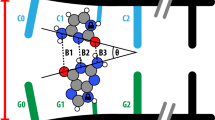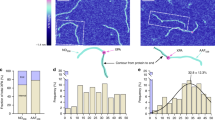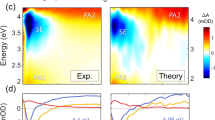Abstract
Solar ultraviolet light creates excited electronic states in DNA that can decay to mutagenic photoproducts. This vulnerability is compensated for in all organisms by enzymatic repair of photodamaged DNA. As repair is energetically costly, DNA is intrinsically photostable. Single bases eliminate electronic energy non-radiatively on a subpicosecond timescale1, but base stacking and base pairing mediate the decay of excess electronic energy in the double helix in poorly understood ways. In the past, considerable attention has been paid to excited base pairs2. Recent reports have suggested that light-triggered motion of a proton in one of the hydrogen bonds of an isolated base pair initiates non-radiative decay to the electronic ground state3,4. Here we show that vertical base stacking, and not base pairing, determines the fate of excited singlet electronic states in single- and double-stranded oligonucleotides composed of adenine (A) and thymine (T) bases. Intrastrand excimer states with lifetimes of 50–150 ps are formed in high yields whenever A is stacked with itself or with T. Excimers limit excitation energy to one strand at a time in the B-form double helix, enabling repair using the undamaged strand as a template.
This is a preview of subscription content, access via your institution
Access options
Subscribe to this journal
Receive 51 print issues and online access
$199.00 per year
only $3.90 per issue
Buy this article
- Purchase on Springer Link
- Instant access to full article PDF
Prices may be subject to local taxes which are calculated during checkout




Similar content being viewed by others
References
Crespo-Hernández, C. E., Cohen, B., Hare, P. M. & Kohler, B. Ultrafast excited-state dynamics in nucleic acids. Chem. Rev. 104, 1977–2019 (2004)
Löwdin, P. O. Proton tunneling in DNA and its biological implications. Rev. Mod. Phys. 35, 724–732 (1963)
Schultz, T. et al. Efficient deactivation of a model base pair via excited-state hydrogen transfer. Science 306, 1765–1768 (2004)
Abo-Riziq, A. et al. Photochemical selectivity in guanine-cytosine base-pair structures. Proc. Natl Acad. Sci. USA 102, 20–23 (2005)
Cadet, J. & Vigny, P. in The Photochemistry of Nucleic Acids (ed. Morrison, H.) 1–272 (Wiley, New York, 1990)
Lamola, A. A. & Eisinger, J. Mechanism of thymine photodimerization. Proc. Natl Acad. Sci. USA 59, 46–51 (1968)
Rahn, R. O. Search for an adenine photoproduct in DNA. Nucleic Acids Res. 3, 879–890 (1976)
Danilov, V. I., Slyusarchuk, O. N., Alderfer, J. L., Stewart, J. J. P. & Callis, P. R. A theoretical study of the cytosine excimer state: The role of geometry optimization. Photochem. Photobiol. 59, 125–129 (1994)
Eisinger, J., Guéron, M., Schulman, R. G. & Yamane, T. Excimer fluorescence of dinucleotides, polynucleotides, and DNA. Proc. Natl Acad. Sci. USA 55, 1015–1020 (1966)
Vigny, P. Fluorescence of polyadenylic acid at room temperature. C.R. Acad. Sci. D 277, 1941–1944 (1973)
Douhal, A., Kim, S. K. & Zewail, A. H. Femtosecond molecular dynamics of tautomerization in model base pairs. Nature 378, 260–263 (1995)
Rahn, R. O., Yamane, T., Eisinger, J., Longworth, J. W. & Shulman, R. G. Luminescence and electron spin resonance studies of adenine in various polynucleotides. J. Chem. Phys. 45, 2947–2954 (1966)
Crespo-Hernández, C. E. & Kohler, B. Influence of secondary structure on electronic energy relaxation in adenine homopolymers. J. Phys. Chem. B 108, 11182–11188 (2004)
Pecourt, J.-M. L., Peon, J. & Kohler, B. DNA excited-state dynamics: Ultrafast internal conversion and vibrational cooling in a series of nucleosides. J. Am. Chem. Soc. 123, 10370–10378 (2001)
Dewey, T. G. & Turner, D. H. Laser temperature-jump study of stacking in adenylic acid polymers. Biochemistry 18, 5757–5762 (1979)
Marguet, S. & Markovitsi, D. Time-resolved study of thymine photodimer formation. J. Am. Chem. Soc. 127, 5780–5781 (2005)
Hosszu, J. L. & Rahn, R. O. Thymine dimer formation in DNA between 25 °C and 100 °C. Biochem. Biophys. Res. Commun. 29, 327–330 (1967)
Ostrowski, T., Maurizot, J.-C., Adeline, M.-T., Fourrey, J.-L. & Clivio, P. Sugar conformational effects on the photochemistry of thymidylyl(3′–5′)thymidine. J. Org. Chem. 68, 6502–6510 (2003)
Samoylova, E. et al. Dynamics of photoinduced processes in adenine and thymine base pairs. J. Am. Chem. Soc. 127, 1782–1786 (2005)
Plützer, C., Hunig, I. & Kleinermanns, K. Pairing of the nucleobase adenine studied by IR-UV double-resonance spectroscopy and ab initio calculations. Phys. Chem. Chem. Phys. 5, 1158–1163 (2003)
Cukier, R. I. & Nocera, D. G. Proton-coupled electron transfer. Annu. Rev. Phys. Chem. 49, 337–369 (1998)
Azumi, T., Armstrong, A. T. & McGlynn, S. P. Energy of excimer luminescence. II. Configuration interaction between molecular exciton states and charge resonance states. J. Chem. Phys. 41, 3839–3852 (1964)
Markovitsi, D., Sharonov, A., Onidas, D. & Gustavsson, T. The effect of molecular organization in DNA oligomers studied by femtosecond fluorescence spectroscopy. ChemPhysChem 4, 303–305 (2003)
Kelley, S. O. & Barton, J. K. Electron transfer between bases in double helical DNA. Science 283, 375–381 (1999)
Lewis, F. D., Zuo, X. B., Liu, J. Q., Hayes, R. T. & Wasielewski, M. R. Dynamics of inter- and intrastrand hole transport in DNA hairpins. J. Am. Chem. Soc. 124, 4568–4569 (2002)
Glisin, V. & Doty, P. The cross-linking of DNA by ultraviolet radiation. Biochim. Biophys. Acta 142, 314–321 (1967)
Kypr, J., Penazova, H., Sagi, J., Pospisilova, S. & Vorlickova, M. UV light-induced crosslinking of the strands of poly(dA-dT) and related alternating purine-pyrimidine DNAs. J. Biomol. Struct. Dyn. 11, 1225–1236 (1994)
Douki, T., Laporte, G. & Cadet, J. Inter-strand photoproducts are produced in high yield within A-DNA exposed to UVC radiation. Nucleic Acids Res. 31, 3134–3142 (2003)
Cantor, C. R., Warshaw, M. M. & Shapiro, H. Oligonucleotide interactions. 3. Circular dichroism studies of the conformation of deoxyoligonucleotides. Biopolymers 9, 1059–1077 (1970)
Acknowledgements
This work was supported by the NIH and performed using laser instrumentation in Ohio State's Center for Chemical and Biophysical Dynamics funded by the NSF. B.K. acknowledges support from the Alexander von Humboldt Foundation.
Author information
Authors and Affiliations
Corresponding author
Ethics declarations
Competing interests
Reprints and permissions information is available at npg.nature.com/reprintsandpermissions. The authors declare no competing financial interests.
Supplementary information
Supplementary Figures S1–S4
These 4 figures show the kinetic data from Figures 2 through 4 on conventional, linear time axes. (DOC 160 kb)
Supplementary Figure S5
This figure depicts the steady-state UV absorption spectra of the investigated compounds before and after 30 min of irradiation at the excitation pump wavelength of 266 nm. (DOC 42 kb)
Supplementary Figure S6
This figure shows the UV-melting profiles for the double-stranded oligonucleotides at 260 nm. This confirms that both (dA)18·(dT)18, and the alternating oligonucleotide, d(AT)9·d(AT)9 are double stranded at room temperature. (DOC 31 kb)
Supplementary Figure S7
This figure shows the room-temperature circular dichroism spectra for the double-stranded oligonucleotides. (DOC 28 kb)
Supplementary Tables S1–S4
These tables list the parameters obtained by global fitting to the kinetic traces presented in Figures 1 through 4 and Supplementary Figures 1 through 4. (DOC 74 kb)
Supplementary Discussion
This file contains discussion regarding the two photon absorption signal seen in the UV probe measurements. (DOC 20 kb)
Supplementary Methods
This file contains the methods used to measure circular dichroism spectra and melting profiles. (DOC 19 kb)
Rights and permissions
About this article
Cite this article
Crespo-Hernández, C., Cohen, B. & Kohler, B. Base stacking controls excited-state dynamics in A·T DNA. Nature 436, 1141–1144 (2005). https://doi.org/10.1038/nature03933
Received:
Accepted:
Issue Date:
DOI: https://doi.org/10.1038/nature03933
This article is cited by
-
A quantum physics layer of epigenetics: a hypothesis deduced from charge transfer and chirality-induced spin selectivity of DNA
Clinical Epigenetics (2023)
-
Nucleotide-amino acid π-stacking interactions initiate photo cross-linking in RNA-protein complexes
Nature Communications (2022)
-
2,6-diaminopurine promotes repair of DNA lesions under prebiotic conditions
Nature Communications (2021)
-
Exciton Absorption and Luminescence in i-Motif DNA
Scientific Reports (2019)
-
P band intermediate state (PBIS) tailors photoluminescence emission at confined nanoscale interface
Communications Chemistry (2019)
Comments
By submitting a comment you agree to abide by our Terms and Community Guidelines. If you find something abusive or that does not comply with our terms or guidelines please flag it as inappropriate.



